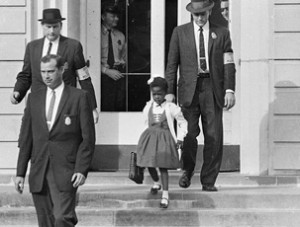Unequal access to quality education is what used to define the Great American Education “Reform” War. It was a civil rights issue. So now, let’s redefine the sides in those terms — give all of America’s children equal opportunity, or not.
The Brown v. Board of Education decision that went into law on May 17, 1954, stated, “separate educational facilities are inherently unequal.” That is a truth. At the time the issue was clearly a racial one – the law ended legal segregation of public schools based on color.
The truth stated in law, then, still stands today — “separate educational facilities are inherently unequal.” And that tendency will always exist. But as James S. Coleman pointed out, inequality exists within schools also. So we must recognize the barriers to equality in our schools and classrooms and fully address those problems directly as well as the inequality between communities.
So what can I say to convince you that federal education law exists because it was the next necessary step in the march towards equal opportunity for children?
Over a decade after the Brown v. Board of Education decision, the 1965 Elementary and Secondary Education Act (ESEA) was written because it was recognized that where poverty exists families and communities are less able to offer the quality of education that richer communities can do for their children. Separate facilities are inherently unequal. Without assistance and support, disadvantaged schools are less likely to offer quality learning opportunities.
The chief architect of ESEA, Francis Keppel, felt that equality in education would only become reality when we provide quality education in all our schools. Simple, not easy. Federal law could help but the final solutions can only happen in schools themselves. For the children’s sake, it is in our schools where the barriers to equality must be recognized.
Keppel went on to write The Necessary Revolution in American Education. He meant a “quality revolution.”
If education is the civil rights issue of our time — like many continue to say — and we know that quality matters, what barriers must we overcome to finish this fight? Children across America deserve better. There is nothing acceptable about inaction when we know there are better policies and practices that we can follow.
For the nation’s sake, we must change the test-based accountability education law — No Child Left Behind (NCLB) (update: now called Every Student Succeeds Act ESSA –same problems)— because it is now a barrier; it is nothing like the anti-poverty, quality-based, federal investment in equality that the 1965 ESEA law was.
Take a step back 60 years, then a step forward to 1965. Ask every one of your federal and state representatives and candidates to do the same. Consider the Three R’s. Roll back, Review,and Reaffirm a commitment to quality and equality. Ask your representatives to do the same.
Every decade, every year, that policy makers drag their feet on NCLB is a sign that they don’t care that children are being denied access to quality education.
The proof is their inaction.

